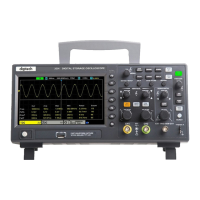User Manual
48
/
76
performed when the oscilloscope is running or stopped.
Press [MEASURE] on the front panel to enter the measurement interface, and press F3 to select the DVM to enter DVM
setting interface.
Press CH1 Enable, CH2 Enable to enable any channel or all channels of DVM.
Press CH1 Type, CH2 Type to select the data type displayed by DVM.
DC RMS: displays the root-mean-squre value of the acquired data.
AC RMS: displays the root-mean-squre value of the acquired data with the DC component removed.
DC: Display the DC value of the acquired data.
The display in the middle of the DVM box is the corresponding ratio of the current measured voltage value to the range
corresponding to the eight vertical grids on the screen with the selected volt/div (turn the volt/div knob).
2.12. Acquire
2.12.1. Run Control
Press the [Run/Stop] or [Single] button on the front panel to run or stop the sampling system of the scope.
When the [Run/Stop] is green, the oscilloscope is running, that is, acquiring data when trigger conditions are met. To stop
acquiring data, press the [Run/Stop] button. When stopped, the last acquired waveform is displayed.
When the [Run/Stop] button is red, data acquisition is stopped. Red "Stop" is displayed next to the trademark logo in the
status line at the top of the display. To start acquiring data, press [Run/Stop].
To capture and display a single acquisition (whether the oscilloscope is running or stopped), press [Single] button. The Single
run control lets you view single-shot events without subsequent waveform data overwriting the d isplay.
When [Single] is pressed, the display is cleared, the trigger mode is temporarily set to Normal (to keep the oscilloscope from
auto-triggering immediately), the trigger circuitry is armed, the Single key is illuminated, and the oscilloscope waits until a
user defined trigger condition occurs before it displays a waveform.
When the oscilloscope triggers, the single acquisition is displayed and the oscilloscope is stopped (the [Run/Stop] button is
illuminated in red). Press [Single] button again to acquire another waveform.
When you acquire an analog signal, the oscilloscope will convert it into a digital one. The real-time acquisition has four
modes: Normal, Peak Detect, Average and High Resolution. The acquisition rate is affected by the setting of time base.
Normal: In this acquisition mode, the oscilloscope samples the signal in evenly spaced intervals to establish the waveform.
This mode accurately represents signals in most time. However, it does not acquire rapid variations in the analog signal that
may occur between two samples, which can result in aliasing and may cause narrow pulses to be missed. In such cases, you

